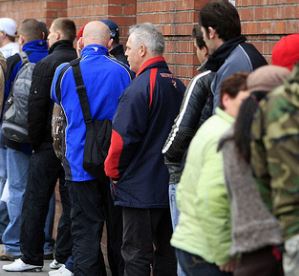New Mexico’s labor force is shrinking

LAGGING: New Mexico finished 48th in the nation in a ranking of the labor participation rate.
By Rob Nikolewski │ New Mexico Watchdog
Judging by unemployment numbers, New Mexico isn’t doing well. The seasonally adjusted rate in August was 6.7 percent — 36th in the nation.
But many experts say the unemployment rate should be looked at in tandem with what’s called the “labor force participation rate,” because the LFPR measures the number of people who have jobs, as well as those who are actively looking for work.
Unfortunately, New Mexico fares even worse in labor force participation numbers — 48th in the nation, according to a recent ranking.
“The policy direction of America matters,” said Matt Mayer, chief operating officer at the Liberty Foundation, a free-market organization based in Oklahoma, which took 2013 data from the U.S. Bureau of Labor Statistics and compiled rankings for all 50 states plus the District of Columbia.
In the Liberty Foundation rankings, only Arkansas, Mississippi and West Virginia fared worse than New Mexico.
Since the U.S. has a population that is retiring in bigger numbers, the labor force participation rate is expected to decline as more baby boomers turn 65.
But New Mexico’s population is 17th youngest in the country, so you would think the state’s rankings in the LFPR would be better than where it stands nationally on unemployment.
But New Mexico finished third from the bottom in the Liberty Foundation rankings, with just 57.5 percent of people in the Land of Enchantment actually in the workforce. The percentage for men is 64.2 percent and barely more than half — 51.3 percent — of women with jobs.
And New Mexico’s numbers have been on the slide in recent years:
There’s often a sharp difference along ethnic lines in national LFPR numbers, but in New Mexico the differences between whites and Hispanics is virtually indistinguishable — 57.4 percent for whites and 57.5 for Hispanics:
The rate for African-Americans in New Mexico is 60.0 percent, higher than for whites and Hispanics. The Liberty Foundation did not have numbers for Native Americans.
Nationally, the LFPR numbers are eroding, too.
Last week the U.S. Department of Labor announced the labor participation rate hit its lowest level since 1978, with 100,000 potential workers giving up their job searches and leaving the workforce. So while the national unemployment rate is at 5.9 percent — its lowest level since the summer of 2008 — the rate is considered artificially low because it doesn’t count those who have given up looking for a job.
What’s particularly troublesome is the Labor Department says the number of young unemployed people is up and their participation rates in the workforce is declining faster than the general population.
So what can be done?
New Mexico Voices for Children, a policy organization with a liberal bent, released a report calling for a host of remedies aimed at young people, including scaling up the state’s Youth Conservation Corps, making the state’s college lottery scholarship needs-based and increasing the minimum wage.
“Raising the minimum wage improves the economy because it puts money into the hands of those who are most likely to spend it — low income workers” the report said.
But Mayer disagrees.
“When you want to jack up the minimum wage,” Mayer said this week in a radio interview in Colorado, it “moves those jobs from 16- to 19-year-olds to an older group of people because you can make more money now. When you create Obamacare, (it) makes it harder for businesses to employ people because they hit a magic number and now they suddenly have to do all these mandates and regulatory requirements. These policies are having (an) enormous tremendous impact on that next generation.”
Which state finished on top of the Liberty Foundation rankings? North Dakota, due in large part due to the shale energy boom that has jolted its economy for nearly a decade. Nearly 73 percent of the North Dakota population holds jobs:
Historically, there’s been a gender gap between men and women participating in the labor force. Some of the reasons include stay-at-home moms and the fact that because women tend to live longer than men, they make up a larger segment of retirees.









